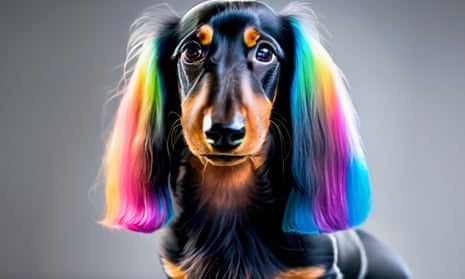The Guardian. 23May2023 by Josh Taylor
Company says Adobe Firefly is a ‘co-pilot’ to graphic design rather than a replacement for humans.
Adobe is integrating its generative AI product, Firefly, into Photoshop, its flagship image editing software. Photograph: Adobe Firefly
Software giant Adobe has announced it will integrate generative AI into its widely used Photoshop program, while downplaying fears the move will lead to job losses and mass fakes.
The brand most associated with image editing will incorporate the generative AI product Adobe Firefly, which launched as a beta six weeks ago, creating a tool the company says will become a “co-pilot” to graphic design rather than a replacement for humans.
Using the “generative fill” feature, Photoshop users will be able to add to, expand or remove unwanted items from images using a text prompt similar to those used by Dall-E and Midjourney, such as “long haired dachshund with long flowing rainbow hair”.
The generative fill feature will be available in the desktop beta from Tuesday, with a wider release set for later in 2023.
Adobe has been using AI in its tools for over a decade, such as the background replacement tool in Photoshop. But the integration of Firefly into Photoshop will expand the offering, allowing for the creation of images and templates from scratch and making for quicker edits to photos.
Since the launch of image-generating AI, many artists have raised concerns that the AI has been trained on artworks under copyright. Adobe has sought to avoid this issue by training the Firefly AI on 100m images from Adobe’s stock library, as well as images in the public domain where copyright has expired.
The director of digital media and strategy for Adobe Asia-Pacific, Chandra Sinnathamby, said the tool would make it easier for small businesses to do their own graphic design, but they were intended as a co-pilot to speed up the process rather than to replace graphic designers altogether.
“The whole idea is: how do we help that creative accelerate, and that content creation at scale, with precision and speed?” he said. “Most campaigns you have to collaborate with various different things. So we how do we accelerate that collaboration process?”
As AI fakes cause confusion online, Sinnathamby said Adobe has tried to set a standard, with content credentials acting as a marker on images that have been created or edited using AI. Adobe has 1,000 members of its content authenticity initiative and has made the technology available broadly since 2019.
“It [is] one of the things that follows this asset no matter where [it goes], and therefore it’s always transparent where the asset the digital asset came from,” Sinnathamby said.
Artists who have contributed to stock photos in the AI library are also identified using this tracking technology and paid when their work is used, according to Sinnathamby.


